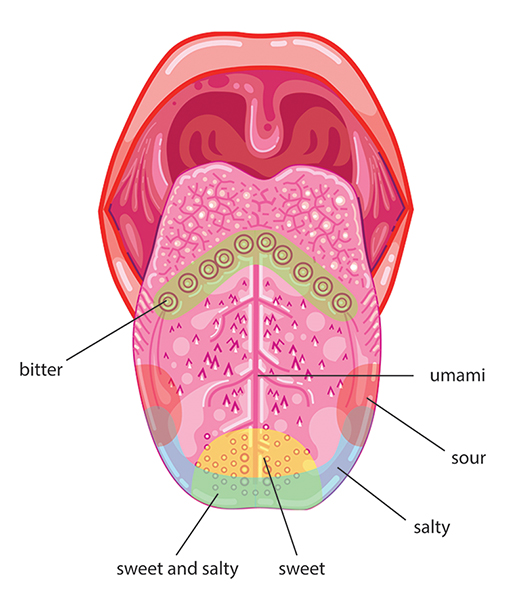4 Taste (gustation)
Cherries and plums fill the nose and the sweet cherry follows through the mouth where it lingers.
If you are a wine connoisseur, you will be familiar with such descriptions and the strong interrelationship between smell and taste. As you have learned, the sensation of flavour is actually a combination of both taste and smell. ‘Gustation’ is the term used for the action of tasting. Humans can distinguish five basic tastes:
- sweet
- salty
- sour
- bitter
- umami (‘oo-ma-me’, savoury or meaty).
Detection of specific tastes occurs across many different regions of the tongue, although some are more concentrated in particular areas as you can see in Figure 6. Umami flavours are detected in the middle portion of the tongue. An overlap of sweet and salty tastes at the front of the tongue is shown.
You can test these yourself by putting some sugar (sweet) or salt (salty) granules onto a wet finger and touching the different areas of your tongue. Now try a spot of vinegar. In what areas did the tastes come out the most?
Take a look at your tongue in a mirror. Why do you think the texture of the top of your tongue is different from the texture underneath?
The tongue is not just for taste. It has several other functions. The top surface of the tongue is in contact with the things you eat and contains ‘papillae’ (bumps on the tongue) which detect different tastes but also textures, for example a smooth or a bubbly beer. The underneath of the tongue is important for shaping the tongue during swallowing and speech and therefore has a higher content of skeletal muscle cells and a different appearance.
Binding of specific ions to taste receptors in the taste buds produces the characteristic taste. For example, a sour taste is the detection of hydrogen ions, and a salty taste is the detection of metal ions, e.g. sodium and potassium. An ion is a charged species which results from the gain or loss of electron or electrons from a particular atom. You will learn more about ions in Week 8 and how they are formed. A sweet taste comes from the ability to detect sugars, both naturally occurring and artificial sweeteners such as sucralose and aspartame.
Thinking back to Week 1 where you learned about corking of wine, why does a corked bottle taste sour?
If you remember, the process of corking was due to a bacteria Acetobacter that turned ethanol into acetic acid which is the chemical in vinegar. This can be written scientifically as shown in Equation 1:
(Eqn 1)In your taste test above, the hydrogen ions in your sour vinegar come from the acetic acid CH3COOH that breaks down in aqueous conditions (such as those within your mouth) to form these ions. This can be written scientifically as shown in Equation 2:
(Eqn 2)
In addition to taste, the tongue communicates other features of the environment to the brain. If you have ever burnt your tongue on a hot drink or eaten a painfully spicy curry, you are well aware that information about temperature, pressure and pain is also sensed by the tongue. These sensations are detected by a separate set of receptors to those that detect taste; instead these are related to the sense of touch.

